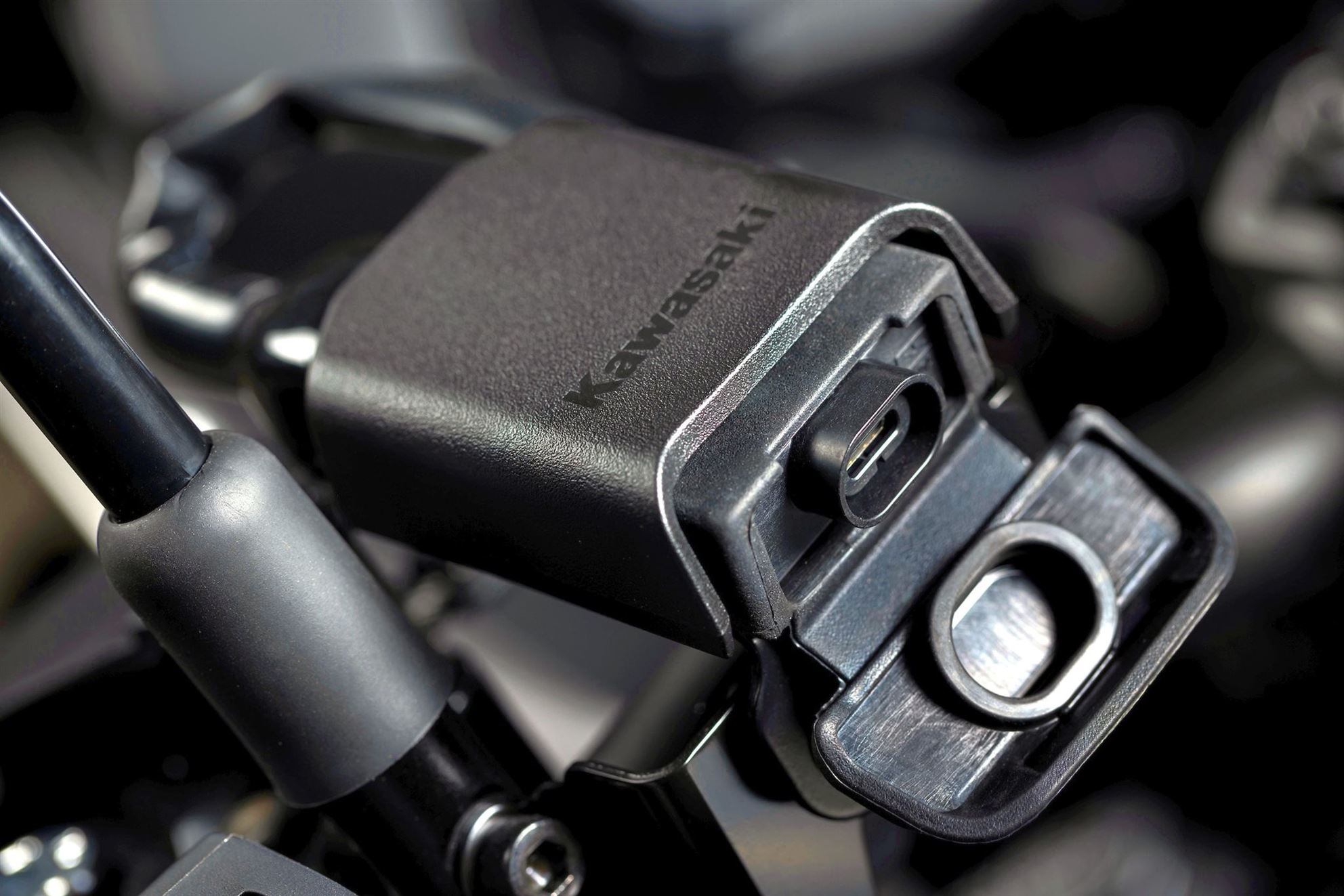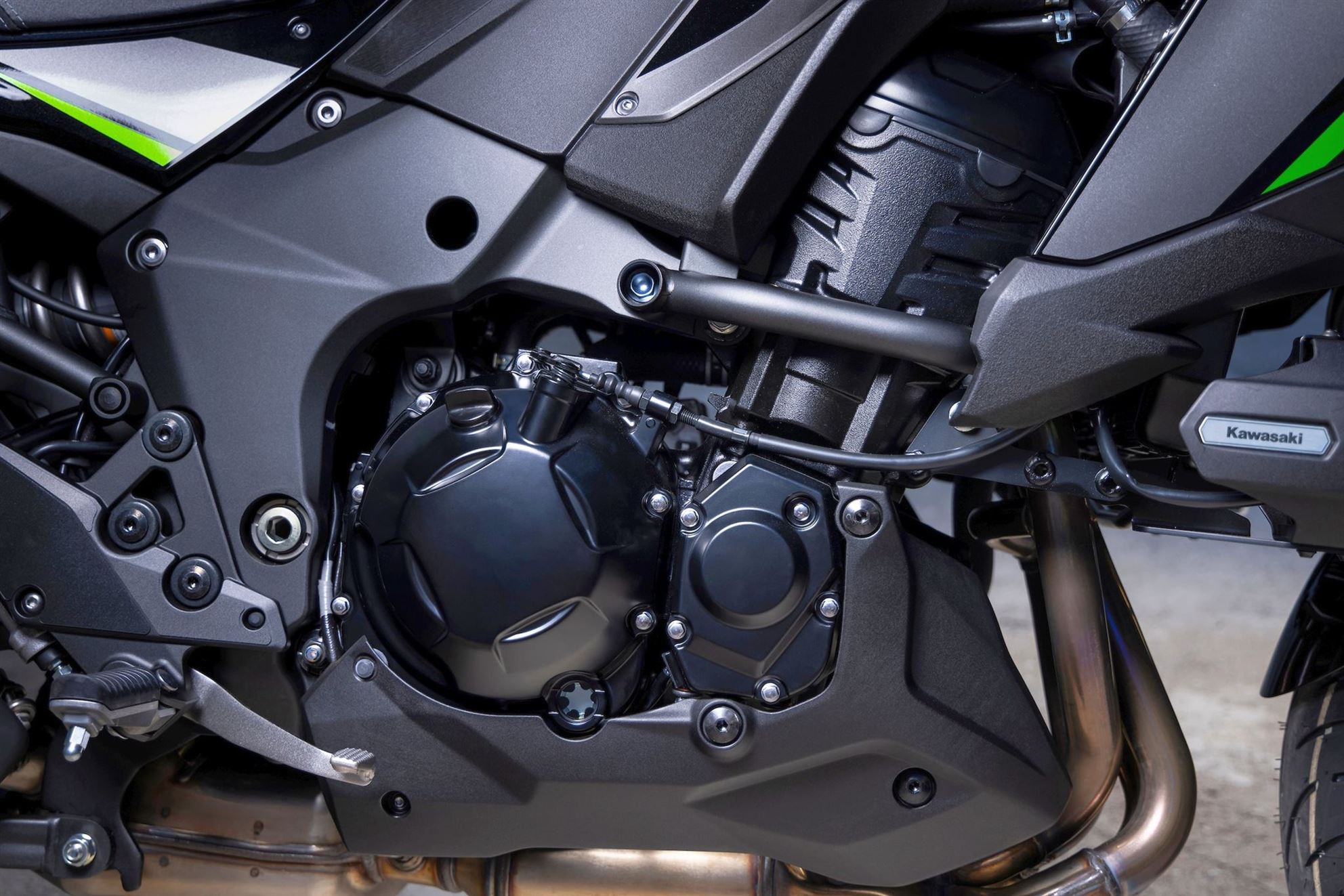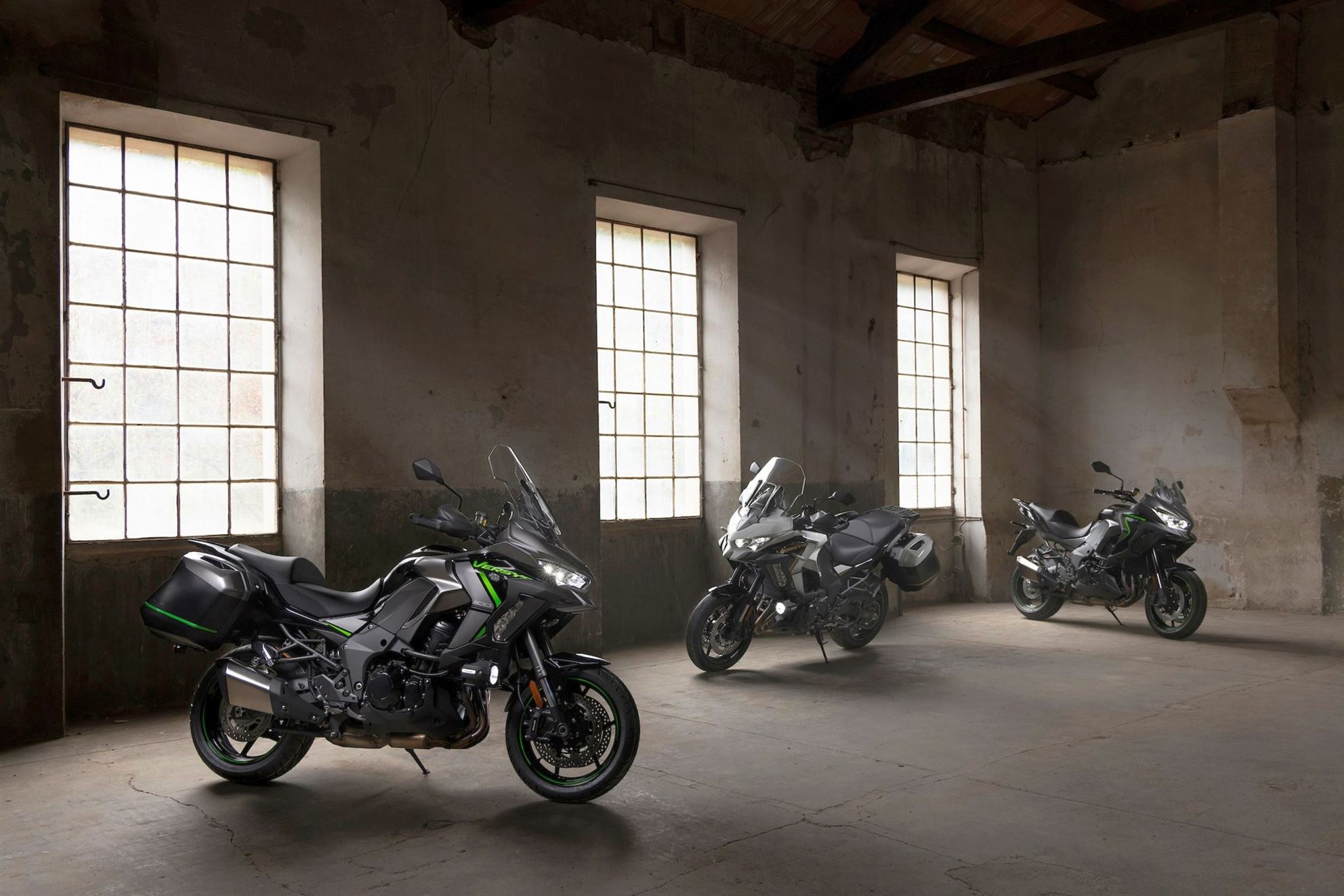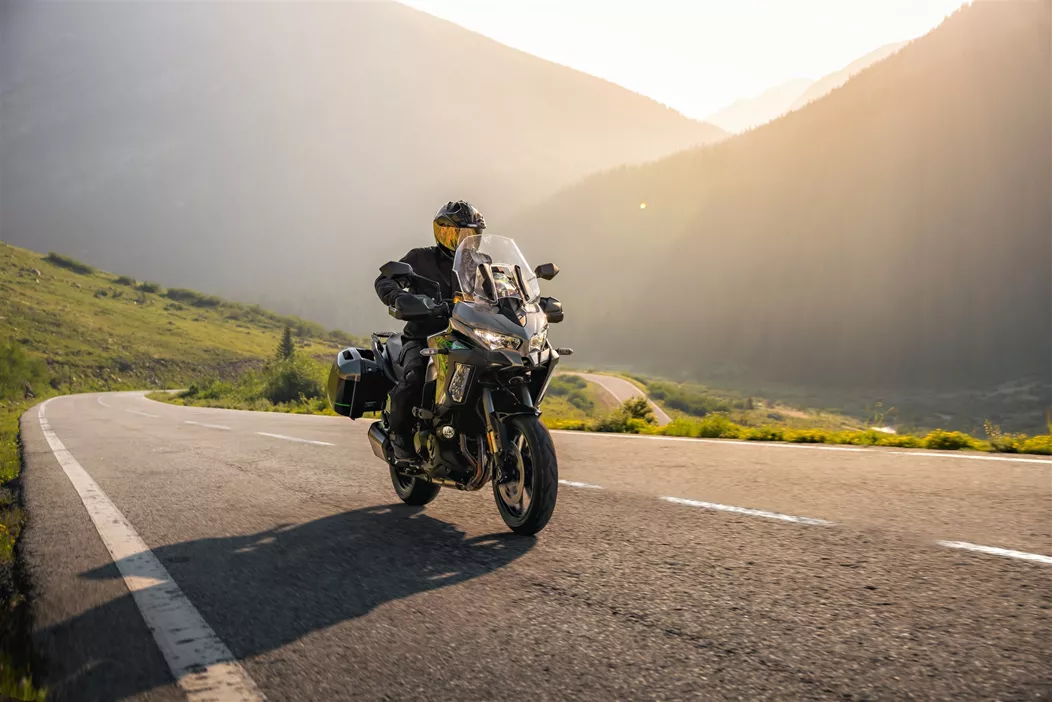"Go everywhere you want" is the premise here, highlighting that with the new Versys, the only limits should be set by the rider. Externally, there are hardly any noticeable changes, as Kawasaki focuses on the inner values. So, what exactly has changed:

Kawasaki Versys 1100 SE Test 2025
Does "Let the good times roll" still apply?
For 2025, Kawasaki is sending their already well-known Versys 1000 into the battle for the best touring bike, now modified with more displacement, more power, and more torque, along with many other improvements, transforming it into the Versys 1100.
&width=72&height=72&bgcolor=rgba_39_42_44_0&mode=crop)
Martin_Bauer
published on 10/18/2024
Kawasaki Versys 1100 SE Engine and Performance
With a modified crankshaft, the stroke of the altered 1100 engine increases by 3 mm, thereby boosting the displacement to 1099 cc. The simultaneous increase in compression aims to deliver more power in the lower RPM range. And the result is impressive - 135 hp and 112 Nm of torque. This places it about 10% above the values of its predecessor, giving it a significant advantage in acceleration. According to the displayed power curve, the engine is expected to significantly outperform its predecessor from 4,000 rpm onwards and deliver 15 hp more at peak power. Further modifications to the flywheel aim to reduce vibration levels and enhance riding comfort. Both the primary and secondary gear ratios have been adjusted to ensure good torque values while keeping the RPM level from getting too high, especially when cruising in the top gear.
How is the ergonomics of the Versys 1100 SE?
On the Versys 1100, the rider sits at a seat height of 840 mm, which, combined with the moderate footpeg height, results in a very relaxed seating position and a comfortable knee angle. The manually adjustable windscreen allows the wind protection to be easily adapted to the rider's torso height. For shorter riders, Kawasaki also offers a seat that is 2 cm lower. This is an option worth considering for those of smaller stature, as the Versys is indeed a bike weighing over 250 kg, and good ground contact is essential when maneuvering at a standstill to avoid tipping over.
Extensive Features & Electronics
Here you will find everything a modern motorcycle should have nowadays. Adjustable pre-programmed riding modes (Sport, Road, Rain) and an additional Rider Mode that can be customized by the rider in all areas as desired. This includes different traction control settings, throttle response, and suspension settings, which are electronically controlled in the SE model. As befits a good touring bike, there is also cruise control on board, which relieves the right wrist, especially on long highway rides.
Even in the colder months, you don't have to forgo the heated grips. Additionally, there's a USB-C port and smartphone connectivity. With the accompanying app and connected headset, many pieces of information can be accessed via voice control. The lighting also utilizes current LED technology and even includes cornering lights through additional headlights integrated into the side fairing.

The USB port of the Versys 1100 SE.
Not to forget is the revised quickshifter, which allows for upshifting and downshifting without clutch engagement. On the Versys 1100, it now works even at very low revs, and you don't have to exceed a certain RPM to activate the system.
Electronic Showa Suspension
In the SE variant we tested, the electronic suspension offered by Showa with Skyhook Technology was installed, featuring a 43mm USD fork. It allows adjustment in compression and rebound as well as in preload. In Rider Mode, the "knowledgeable" can even adjust these settings independently and thus customize the suspension according to their preferences. In the other riding modes, a predefined setting is used that matches the configuration. So even those who do not want to delve deeper into suspension setups will find a good solution.
Kawasaki Versys 1100 SE Riding Impression
What immediately stands out is the relaxed seating position, which with a seat height of 840 mm probably provides a very good base for most riders over 170 cm. For shorter riders, it becomes particularly challenging when maneuvering with attached luggage systems. However, there is a lower seat option available. While the nearly 260 kg is noticeable when stationary, it is hardly noticeable during the ride. Thanks to the wide handlebars and nimble chassis geometry, the Versys can be moved swiftly even on narrow roads without causing instability at higher speeds. From around 170 km/h, even with a luggage system, there is only a slightly spongy feeling in the steering, and from 200 km/h, a slight "wobble" occurs, which remains manageable. This is not always a given for a touring bike with a high windshield and panniers. Moreover, these speeds are likely to be reached only rarely, and if so, then on our German neighbors' highways. What stands out positively at higher speeds is the excellent wind protection, even with the windshield in the lowest position. You feel no wind pressure from the front and hardly any turbulence. This keeps the helmet free from forces and annoying vibrations. Additionally, you can look over the windshield onto the road, which always provides an undistorted view of what lies ahead, even if the screen is dirty.
Fortunately, the Versys still relies on road-oriented 17-inch tires, which somewhat limit its use in light off-road conditions and thus the claim "Go everywhere you want." However, they score all the more on the road. And the road will likely be the main area of use for the Versys, as the suspension setup also indicates.

The Versys 1100's domain is on the road.
The electronic suspension is very responsive and tends to be on the firmer side, especially in Sport and Road modes. While it provides a lot of feedback for spirited riding, it sacrifices some riding comfort on uneven surfaces. However, the adjustable settings in the Rider Mode offer a remedy, allowing each parameter of the suspension to be tailored individually. Given the generous range of adjustments, one can find a good solution for riding comfort that doesn't feel overwhelmed even at a brisk pace. Different loads or rider weights can be accommodated with various preload settings, also electronically and independently of the riding mode. Thus, every rider can find their desired setting according to their preferences.
The engine behaves as expected from a 4-cylinder inline engine. Smooth running and, thanks to the large displacement, already with good power from the bottom, the engine pushes the bike assertively forward. From 4,000 rpm, you feel the increasing power, and between 6,000 and 8,000, it really moves forward. The rev limiter kicks in at around 10,000 rpm, although extreme revving of the engine doesn't make much sense. Although the engine is really fun, there are, of course, stronger engines in this segment today. However, these are only available at significantly higher prices.

The engine of the Kawasaki touring bike.
The translation is well done and strikes a balance between good torque values and touring-friendly low revs. In the last gear, at 100 km/h, the engine runs at about 4,000 RPM. This is exactly the RPM where the engine adds more power and thus pulls well even in the last gear. You can glide through towns in the last gear at around 2,000 RPM without it being problematic for the engine. It pulls away cleanly from there, although you shouldn't expect brutal acceleration.
The quickshifter is also well-executed. It allows for buttery smooth gear changes without power spikes, even at low revs, which are typically challenging for quickshifters. This often tempts you into making gear changes that aren't really necessary. Only the somewhat soft shift actuation slightly diminishes feedback. However, thanks to its excellent function, the next gear always engages securely.
Kawasaki Versys 1100 Versions and Colors 2025
The new Versys will be launched in 3 different versions. There is the Standard, an "S", and the top model and the one we tested, the "SE" variant. While the S already includes many nice features compared to the Standard, such as a quickshifter, adjustable windshield, handguards, heated grips, riding mode, TFT display, and connectivity, the SE takes it up a notch with the electronic suspension. However, all three versions feature a non-adjustable ABS and a unified braking system, which consists of a dual disc setup with a 310 mm diameter at the front and a 260 mm disc at the rear. This has grown by 10 mm compared to its predecessor.

The versions of the Versys 1100.
Of course, there is also plenty from the Kawasaki accessory program such as the luggage system, navigation mount, additional headlights, frame protectors, and much more. Current prices for the Versys 1100 models can be found here: Kawasaki Versys 1100 Prices 2025.
- How much does a Kawasaki Versys 1100 SE cost?
- Here you will find an overview of the price level of new and used motorbikes!
&width=60&height=60&bgcolor=rgba_39_42_44_0&mode=crop)
Kawasaki Versys 1100 SE 2025 - Experiences and Expert Review
Martin_Bauer
With the new Versys 1100 SE, Kawasaki certainly manages to make a mark in the touring segment. With its solid engine and well-functioning systems, the Greens definitely counter in terms of price/performance ratio. With high riding comfort, the new Versys 1100 SE is sure to expand its fan base and more than live up to the eternal slogan "Let the good times roll."
More from 1000PS Magazine
Kawasaki Versys 1100 SE Test 2025 Images
Source: 1000PS













































































































